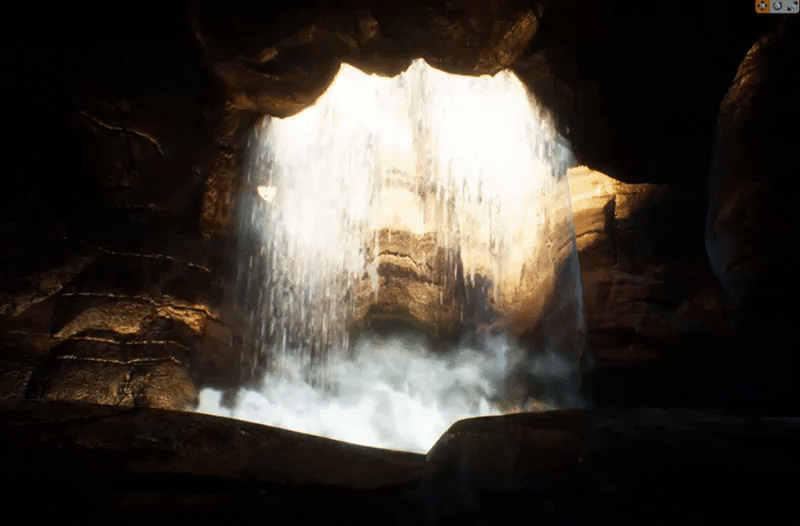

Below is the breakdown for the effect shown above. This effect is a realistic waterfall in a cave or around rocks. It is accomplished using a combination of meshes, materials, and particles. Some notes about this scene. It was created in Unreal Engine 4, version 4.19. The particle systems were created using the Cascade system, and not the most recent Niagara system. However, the theory and techniques remain the same. Press play below to view the breakdown in motion.
https://s3-us-west-2.amazonaws.com/secure.notion-static.com/6e05c7b3-76c7-4597-bc17-f59758239055/Waterfall_Breakdown.mp4
As you can see, there is a mesh with a panning material applied to it, several particle effects with multiple panning noises, controls for contrast, opacity, depth fade, alpha over life, and color over life.

Not shown: Light caustics effect. Use the panner mesh to reinforce the volume of the waterfall particle(s). Mist (down) should be positioned at the top of the waterfall to indicate either turbulent flow or air movement. At the bottom of the waterfall will be the water drops particle, water splash particle, and the mist (up) particle.

Edited image so that effects are more clear when separated.
The material setups and particle systems setups are all rather simple to achieve the totality of this effect. I will not cover each of those setups here, but if you would like to learn more then you may also take a look at Tyler Smith's tutorial or Jeremy Griffith's tutorial on The Gnomon Workshop.
Some pictures of my particular materials are below for your reference; generally you want to use saturate to clamp the opacity between 0-1 (this is a specific clamp function for only the 0-1 space, so it is cheaper than a normal clamp node in a material), multiply the particle color (or plug it directly) against the alpha noise(s), and use lerps or power nodes to control the transition between different aspects of an effect (e.g., splash shape alphas) or contrast of the alpha respectively. Shown below, the particle color is multiplied against a 3 vector parameter to make accessing the color options easier (changing color in a parameter in the material instance, rather than having to go into the particle system itself and changing the curves in the Color Over Life module).


The most important part to creating a believable waterfall is going to be your reference, textures, and the lighting. Your choice of reference will make a large difference in how you approach a waterfall. Waterfalls have a wide variety of looks depending on their source, pressure, velocity, height, turbulence, dispersion, and dissipation. Secondly, your textures can make or break the look of the waterfall particles, creating either heavy turbulent (cloud-like) flows, streams, or beads. Under normal, exterior lighting situations you may be able to set your material to an unlit shading method. This method makes the effects more apparent in exterior settings, but the drawback is that you lose control over lighting the effect. I have found that by using a Translucent blend mode with a Volumetric Directional lighting mode yielded the best results in an interior, dimly lit scene such as my cave. This was the correct choice because I was able to more carefully control how the waterfall was lit, and therefore how it interacted with the surrounding environment, yielding a more believable result.
Aside from materials work, your particle systems will need velocity appropriate for the effects you are generating. Water moves rapidly, even in small height situations.
Once you understand these basics, reproducing a waterfall for your own projects is manageable. Don't be fooled though, water and waterfalls are notoriously difficult real time vfx to pull off in a believable manner, with expert vfx artists often spending lengthy amounts of time on them. It has been said by some of these artists that each waterfall is so unique that while you may create each effect necessary for the overall waterfall separate and reuse them, it will still require extensive time and setup to achieve a believable effect.